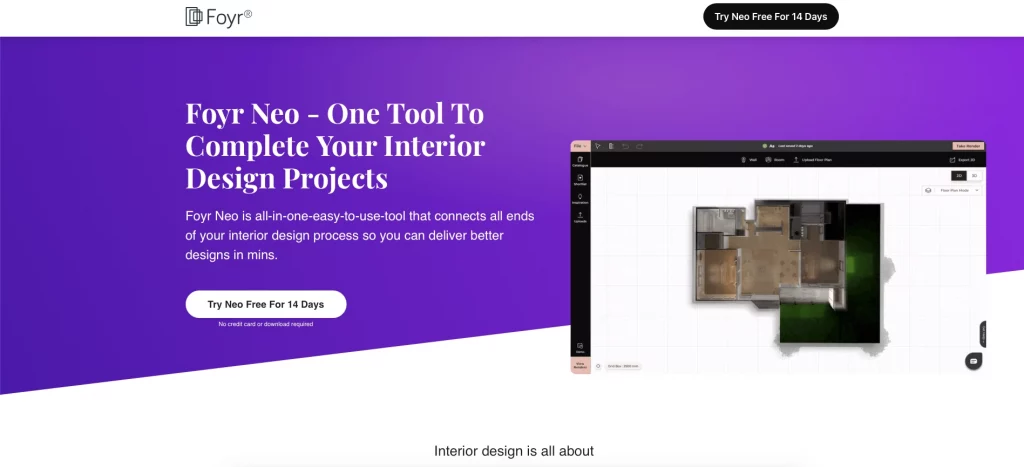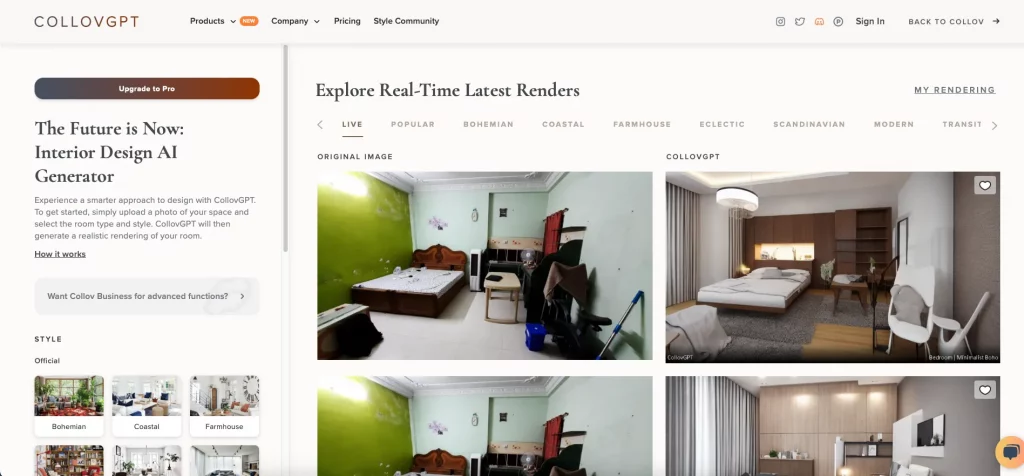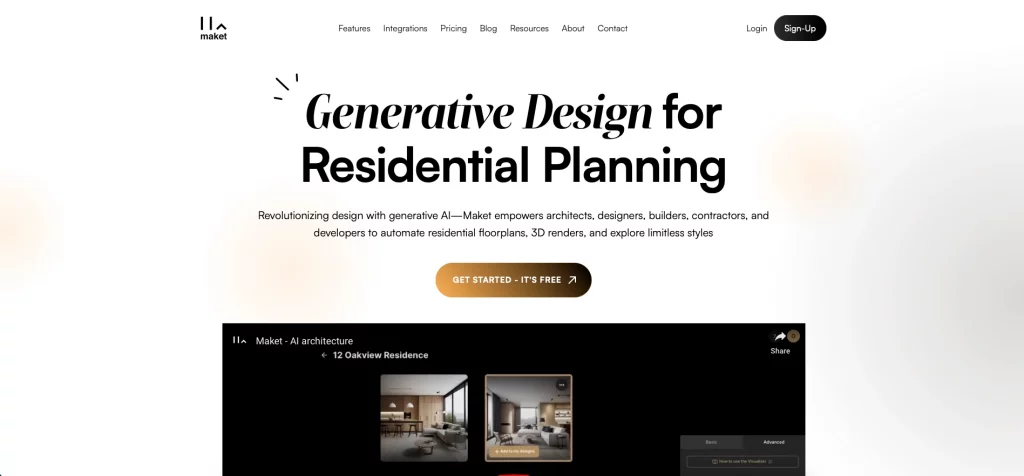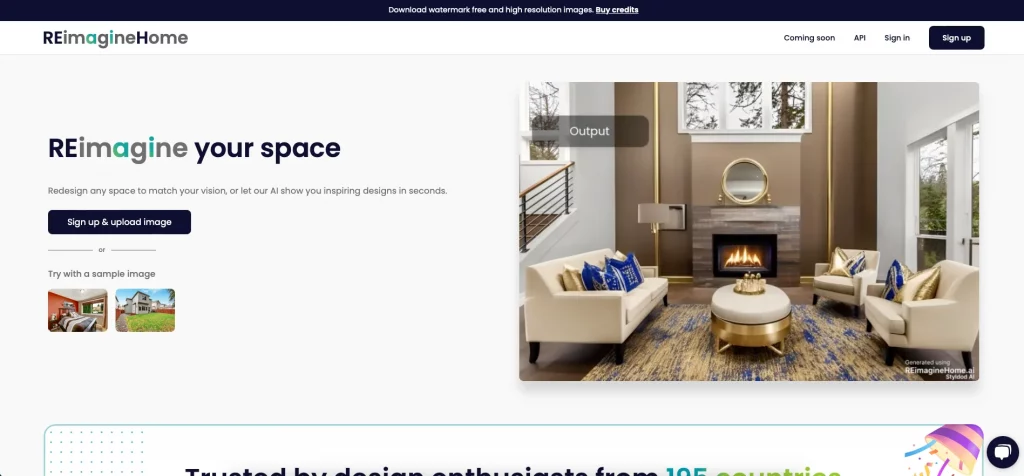Table of Contents
Traditionally, design has always relied on three things – human expertise, imagination, and iterative exploration. However, in recent times, the emergence of AI has created a tectonic shift in the way designs are created. AI has augmented and accelerated the design process in ways previously unimaginable.
The fusion of AI into design has birthed the concept of Generative Design. Generative Design is a process of iterative design exploration where AI algorithms are used to generate an array of design solutions. Unlike traditional design, Generative Design doesn’t rely on a model created by an engineer to kickstart the proceedings.
In this post, we will delve into the world of generative interior design, where we will understand how the fusion of AI and creativity can reshape the very fabric of artistic expression and problem-solving.
Unveiling Generative Design Concepts
Generative design is all about establishing synergy between human designers and advanced AI algorithms. At its core, generative design begins with defining a set of design parameters. The AI algorithms then generate a multitude of design alternatives that adhere to these parameters. This iterative process keeps refining itself and selects the most promising design concepts. In the end, it presents designers with a plethora of innovative options that might have remained undiscovered using conventional design methods.
In any generative design software, you will find sophisticated AI algorithms that employ complex mathematical models, optimization techniques, and pattern recognition to explore design solutions. These AI algorithms sift through countless possibilities and produce novel solutions that most human designers might overlook.
Some of the key benefits of generative design technology include:
- Generative design tools can manage multiple design iterations at the same time.
- Generative design results in the automation of many of the manual and time-consuming activities involved in ideation and design. Instead of spending time on these activities, you can focus more on other critical activities.
- Generative design is quite easy to learn. This means even entry-level designers with basic knowledge of design software can adopt it.
The Evolution of Generative Design with AI
Throughout history, traditional design processes have faced limitations majorly due to the complexity of problems, human cognitive constraints, and the constraints of time and resources. Manual design iterations and trial-and-error often fell short of unlocking the full spectrum of creative possibilities.
Generative design emerged as a groundbreaking solution to all these challenges as they presented a departure from linear design methodologies. The AI interior design generator took this further, transforming how interior designers approach space planning and decoration by using artificial intelligence to generate innovative, resource-efficient solutions.
By optimizing new designs for efficiency, high-performance, and resource utilization, generative design propelled these industries by helping them create structures, vehicles, and products that were previously deemed unattainable. The fusion of AI-driven innovation and human expertise also helped in reducing material waste and enhancing resource utilization.
Read also – 5 AI-Powered Interior Design Software Tools in 2023: Revolutionizing The Industry
Core Elements of Generative Design
Generative design is a multi-faceted process. Within its intricate architecture, you can find three core elements. Here are they –
Input Parameters: Defining constraints and objectives
Designers and engineers outline constraints and design goals as part of the input parameters. They delineate the space and satisfy spatial requirements and material preferences, all within budgetary limits. They serve as the guide that helps the Generative design tools to build designs that echo human intent.
Algorithmic Creativity: Generating diverse design alternatives
Algorithmic creativity of generative design happens thanks to the iterative exploration of possibilities. AI algorithms, driven by advanced mathematical models, optimization techniques, and the vast repository of past designs, navigate the design space endlessly, looking for ideas. Using these ideas, the tools generate an array of solutions that range from highly pragmatic to highly artistic ones.
Evaluation Methods: Selecting the best-suited solutions
In this, the Generative Design algorithm performs a thorough analysis and evaluates each solution’s alignment with the parameters and objectives. Factors like functionality, aesthetics, and feasibility are carefully weighed, guiding the selection of solutions that not only meet the criteria but are also sensible.
Industries Transformed by Generative Design
Generative design has been revolutionizing a variety of industries, but the architecture and interior design industries benefited the most with it.
Architects have been using generative design to envision unique and innovative design possibilities. It has accelerated creativity, leading to structurally efficient and aesthetically pleasing buildings in recent times.
In interior design, generative design tools suggest room layouts, furniture arrangements, and material choices, optimizing spaces for functionality and beauty. The fusion of generative design and human creativity has made the appeal and functionality of existing houses better, thereby offering novel experiences to inhabitants.
Generative design has also extended its transformative capabilities to product development and manufacturing processes. Generative design tools suggest intricate, lightweight designs to manufacturers, reducing material use and improving product performance. This approach is particularly evident in industries like automotive and aerospace, where generative design generates components with remarkable strength-to-weight ratios. This not only enhances functionality but also drives resource efficiency and better manufacturing methods.
Tools and Software for Generative Interior Design
Here are 5 top tools for generative interior design –
1) Foyr Neo
Foyr Neo makes designing super easy and quick, thanks to its generative design capabilities. It ensures that you can spend more on strategic tasks related to the design process while it takes care of the actual design activities. All you need to do is upload or create a floor plan, add 3D models to your rooms, and let Foyr Neo make amazing 4K images in minutes. Foyr Neo works online. This means you can create awesome designs, impress clients, and win projects without using up your computer’s space.
2) Autodesk 3Ds Max
Image credits: Autodesk
Through intricate modeling, realistic rendering, and precise detailing, Autodesk 3ds Max allows designers to craft lifelike representations of interior spaces. The software uses generative design and its extensive library of textures, materials, and lighting options to enhance the level of realism. This enables designers to visualize how different elements will interact under various lighting conditions.
Read also – AutoDesk 3D Rendering Alternatives – Best Rendering Software
3) CollovGPT
Image credits: CollovGPT
CollovGPT is an interior design tool that uses generative AI to provide multiple virtual staging and mockups of your rooms. It lets you conceptualize your redesigned rooms and also helps you visualize what your design will look like in 3D. This makes it easier to decide what you want and communicate your vision to a customer. The tool is free to use, and all you need to do is upload your photo and select your room type and style preference.
4) Maket.ai
Image credits: Maket.ai
Maket enables architects and interior designers to instantly generate thousands of architectural plans that are aligned with their input parameters and constraints. This generative design tool offers real-time collaboration where multiple key stakeholders can interact with each other about a design on the same platform. You can specify input parameters like room dimensions, adjacency, and custom land/building constraints, and Maket returns multiple AI-generated floor plans.
5) REimagineHome
Image credits: REimagineHome
REimagineHome.ai harnesses the power of generative AI to redefine interior design and real estate. With a mere photo of your living space, the tool can generate a wide collection of design themes and room styles that are precisely tailored to your preferences. The tool’s user-friendly interface accommodates even designers with limited technical experience.
The Impact of Generative Design on Sustainability
Generative design has completely altered the way we pick materials for products and solutions, making them more sustainable. The simplest example would be designers comparing wood and metal to see which is better and sustainable for a particular product. They can also set criteria like age or type of material and see the best options visually. There are chances that you might pick something cheaper but eco-friendlier than the more expensive option. Generative design makes such scenarios possible.
Generative design makes designing and testing easier as it uses computer simulations to check how things like stress and wear would affect a particular design. This means you don’t have to keep building and altering physical prototypes, which saves time, materials, and money.
Read also – Green Living: 10 Ways to Turn Your Home from Toxic to Eco-friendly
Ethics, Creativity, and Human Involvement
AI-driven generative design can obviously bring forth questions about ethics, particularly those related to intellectual property, originality, and responsible usage. It often makes us contemplate the implications of AI-generated designs, especially when they appear to blur the lines between inspiration and replication. As a designer, you must be careful to avoid unintended copying of existing designs and must focus on the responsible utilization of generative design.
Besides ethical considerations, generative design makes us ponder about the differences between machine-generated ingenuity and human creativity. While AI algorithms indeed excel at sifting through a vast collection of design spaces and generating innovative solutions, the unique spark of human imagination remains irreplaceable. The idea is to strike a harmonious balance between the algorithmic capabilities of generative design and the human touch that fills designs with character. This synergy gives rise to designs that are not only functional but resonate on a deeper aesthetic and emotional level.
All this leads to one thing – human designers emerge as the ultimate custodians of designs. Their role goes beyond merely overseeing the generative design tool; they must curate the results and align them with the intended message and purpose. Designers must also guide the tool by setting the initial parameters and the trajectory for the generative process. In summary, human involvement is pivotal in upholding the integrity and ethics of the design process and ensuring that AI is harnessed in the right way for better outcomes.
Shaping the Future of Interior Design with Generative AI
The field of interior design is undergoing a profound transformation, mainly catalyzed by the rise of generative AI tools. Looking ahead, we can make several predictions that will shape the future of this dynamic field. For instance, it’s not far when generative AI tools will comprehend and implement even more intricate design nuances.
With advancements in machine learning and pattern recognition, these tools will craft interiors that suit individual preferences, lifestyles, and cultural influences to a greater extent. Furthermore, the integration of virtual and augmented reality could enable immersive previews of AI-generated interior concepts, allowing clients to experience designs before they’re brought to life.
Generative AI will also democratize interior design, breaking down traditional barriers that limit access to creative expertise. Generative AI tools will enable individuals even with limited design knowledge, to envision their ideal spaces. With simple inputs, they will be able to generate designs that will encapsulate their ideas. This democratization will even extend beyond individual projects, potentially inspiring a collective reimagining of urban spaces, workplaces, and homes.
Remember – the future of interior design revolves around the blend of AI systems and human designers. Rather than AI replacing designers, these tools will augment and elevate human creativity. There will be a harmonious collaboration where designers leverage AI-generated concepts as inspiration and building blocks, infusing their unique artistic insights and emotional understanding.
Conclusion
Generative design shows us how powerful artificial intelligence can be. If you are a designer looking to improve your efficiency, there is no doubt that you need to embrace generative design. This new way of solving problems can also inspire you to think in ways that were previously unimaginable. This compelling evolution paves the way for a fresh era of design thinking, where AI becomes a collaborator and a catalyst, propelling us towards solutions that inspire all.
FAQs
Generative design uses artificial intelligence to explore many design options based on given parameters, thereby aiding innovation in design.
An example of generative design is generating various room layouts based on specific requirements like space dimensions, functional needs, and aesthetic preferences.
Yes, generative design is a 3D CAD(Computer-Aided Design) capability. It autonomously creates optimal designs from a set of system design requirements.
Generative design in interior design employs AI to suggest diverse layout options based on input parameters.















